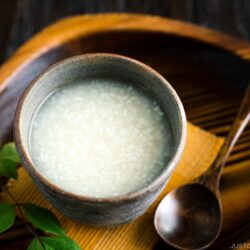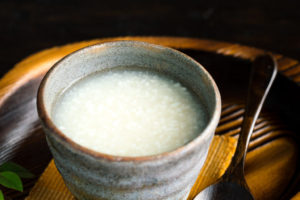
When I was younger, I always associated amazake (甘酒) with the taste of alcoholic sake. It was that distinct aroma of sake in the drink that gave me the impression that it would be too strong, so I would always pass on the drink when someone offered it. I didn’t know there was a non-alcoholic version then.
What is Amazake?
Amazake (pronounced ah-mah-ZAH-kay) is a traditional Japanese drink made of fermented rice. Literally means “sweet” (甘) “sake” (酒), it has a creamy, thick consistency with a sweet flavor, served either chilled or warm/hot. Although it is commonly called sweet sake, Amazake can be made either with low-alcohol or non-alcohol.
The history of amazake goes back to the Kofun period (250 to 538 AD), mentioned in The Nihon Shoki (日本書紀) or The Chronicles of Japan – the second-oldest book of classical Japanese history.
There are 2 Types of Amazake. Alcoholic amazake made with sake lee (the one I didn’t like growing up), and the non-alcoholic amazake made with rice koji. I now enjoy both types of amazake and they have been my favorite winter comfort drink for many years.
By the way, if you are familiar with the Korean sweet rice drink (sikhye) that is served complimentary at the end of a meal at a Korean restaurant, you may think amazake is the same drink. It is not. Amazake is made with rice, water, and sake lees (酒粕) or rice koji (米麹), while sikhye is made of malted barley flour, rice, sugar, and water.
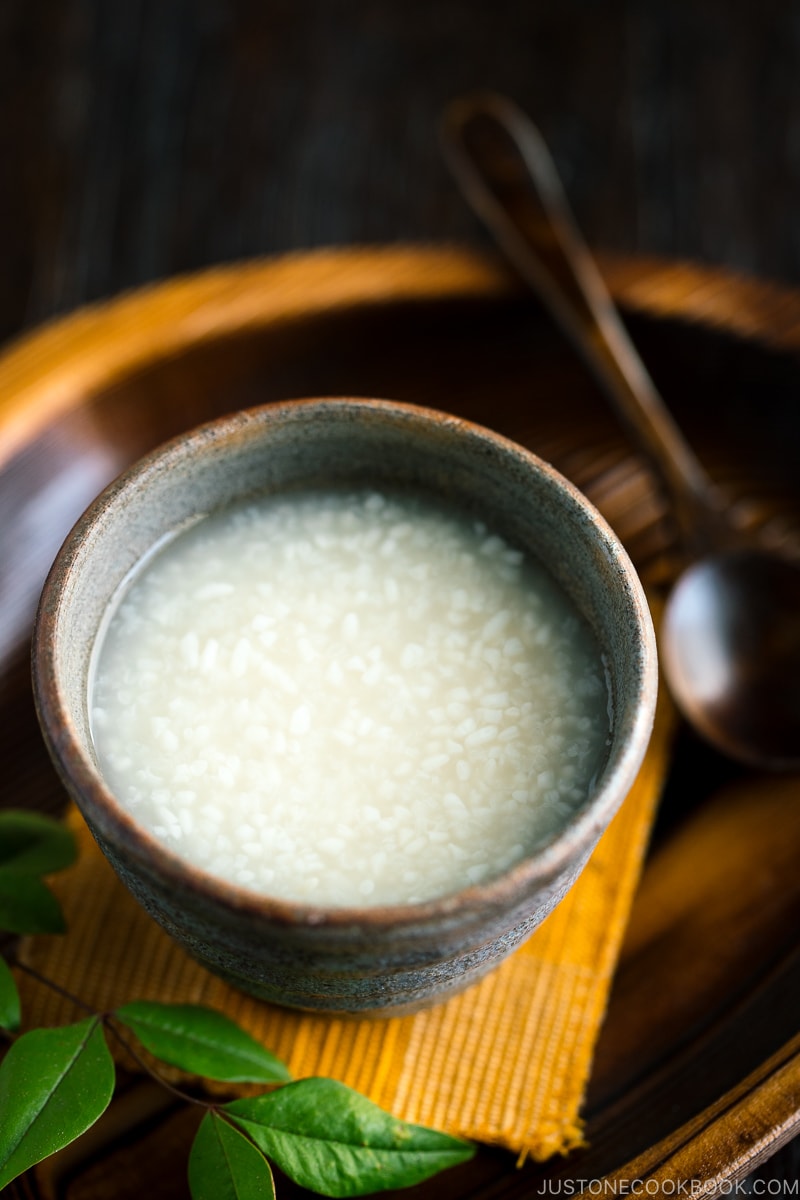
Non-Alcoholic Amazake Made with Rice Koji
- Non-alcoholic; can be enjoyed by everyone including small children and pregnant ladies
- Made with rice, rice koji, and water
- Can be time-consuming to make
- Temperature control is very important
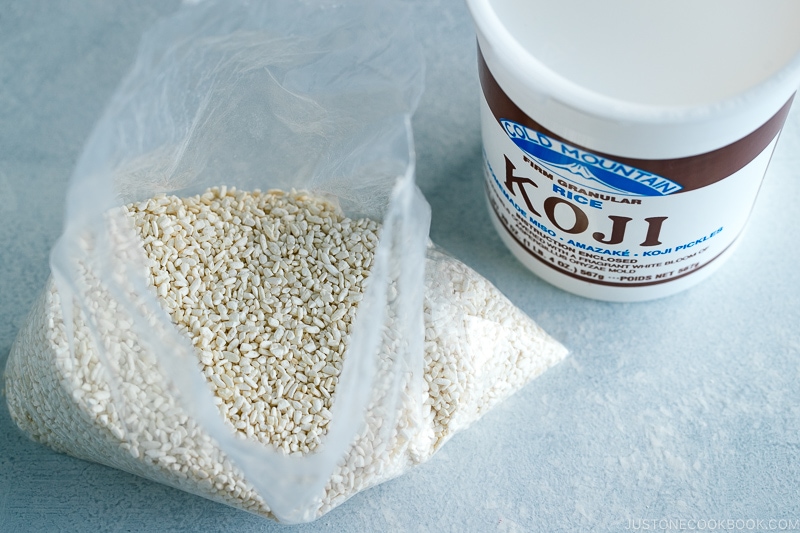
Rice koji (kome koji 米麹) is rice that is covered with kōji mold (Aspergillus oryzae). As you may already know, kōji mold is used in making many Japanese fermented foods such as miso, soy sauce, mirin, and sake. It helps create some of the most important Japanese ingredients, and maybe one of the contributing reasons to Japanese longevity!
You can buy rice koji (including one above from Cold Mountain) at Japanese grocery stores (refrigerated section near miso), or Amazon.
To make amazake, ferment the rice with rice koji at 125-140 ºF (50-60 ºC) for 8 to 10 hours. This particular temperature range is the most suitable temperature for the enzyme to break down the starch into glucose/sugar.
Low-Alcohol Amazake Made with Sake Lees
- Alcoholic (8%)
- Made with sake lees, sugar, and water
- Easy method
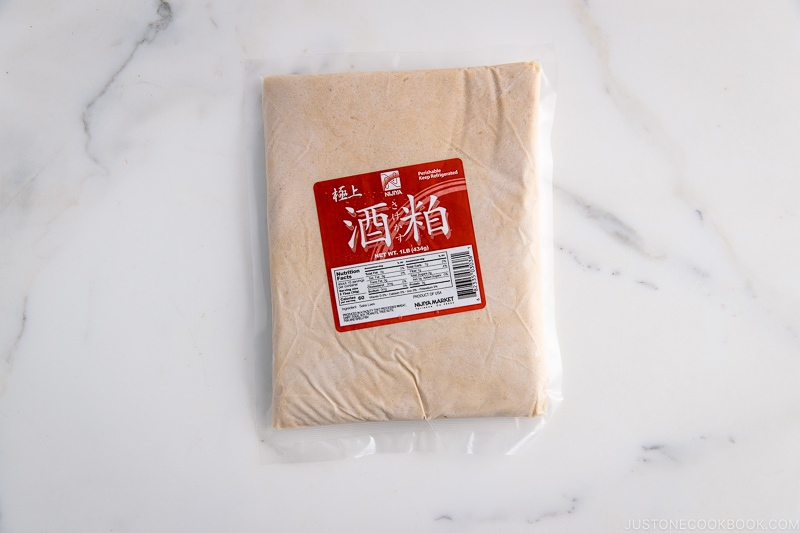
Amazake made with lees left from sake production (sakekasu 酒粕) is a low-alcoholic drink (8% alcohol). Sake lees are dissolved in hot water and sugar is added to sweeten the lees.
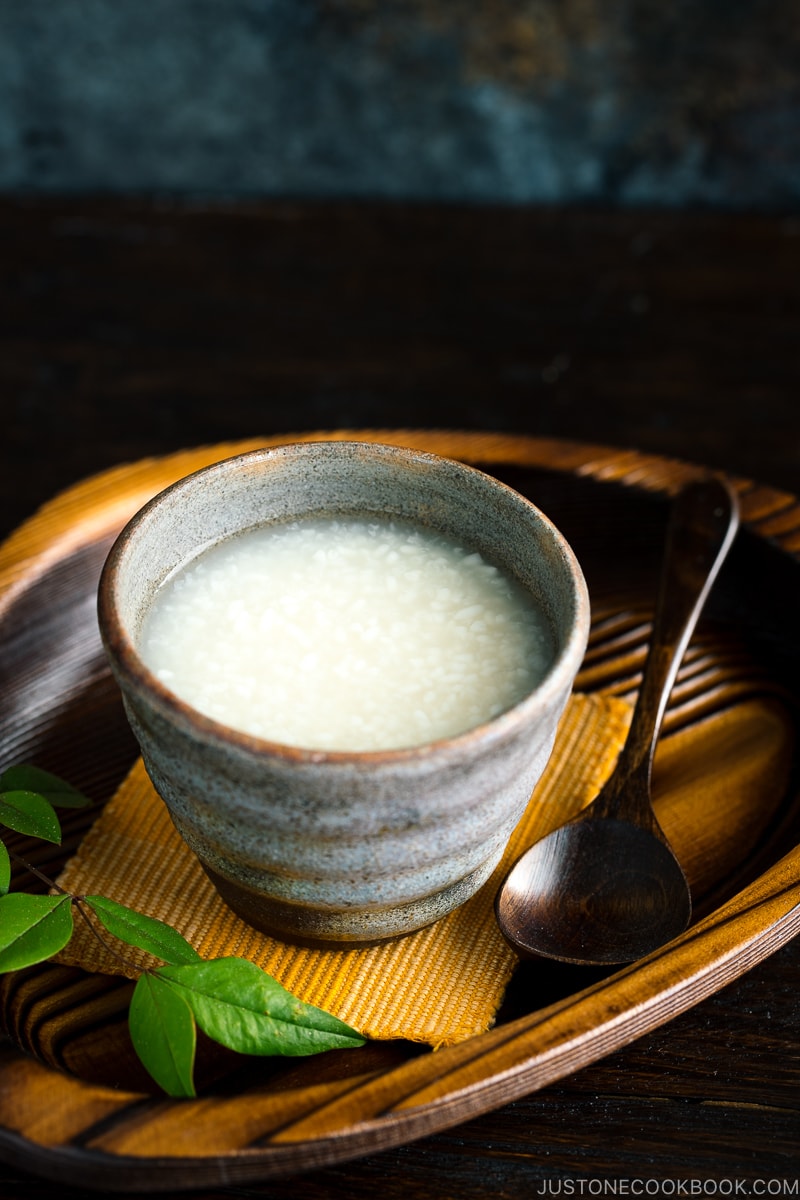
Benefits of Drinking Amazake Made with Rice Koji
Amazake made with rice koji has more nutritional value than the one made with sake lees, and it’s called the “IV drip to drink”「飲む点滴」in Japan.
This fermented rice drink is packed with nutrients, including vitamin B1, vitamin B2, vitamin B6, folic acid, ferulic acid, dietary fiber, glutamine, and a large amount of glucose – which are almost the same components as an IV drip, hence the catchy nickname for amazake.
Benefits of drinking amazake:
- anti-aging
- improved skin (prevent spots and freckles, skin lightening, moisturizing)
- increased metabolism
- fatigue recovery
- improved digestion
- strengthened immune system
Even though amazake is good for you, it is important to enjoy the sweet drink in moderation, especially if you’re diabetic. Just one cup (200-250 ml) of amazake in a day is enough to provide you with these health benefits.
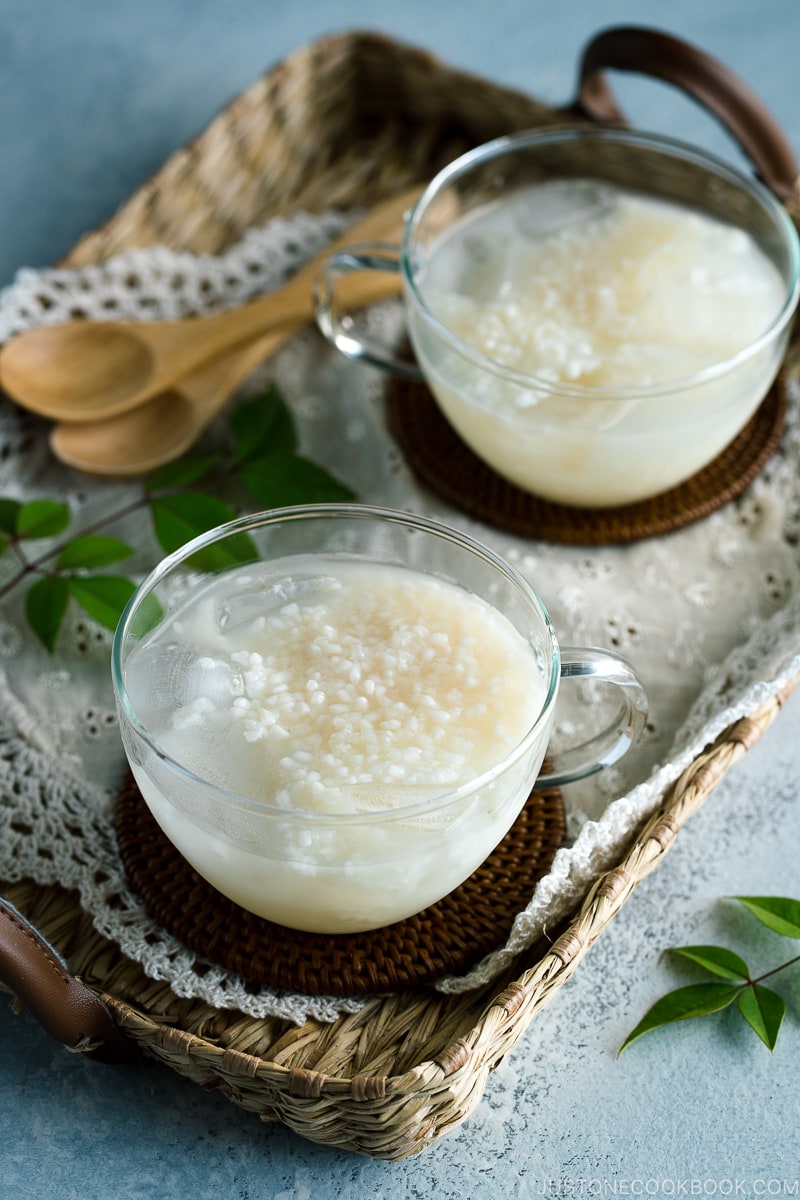
Tips to Make Amazake at Home
Amazake with Rice Koji
- Temperature control is the key! You need to maintain the rice and rice koji mixture between 125 and 140 ºF (50-60 ºC) at all times (8 to 10 hours).
- If the temperature is too high, the enzyme of koji does not work sufficiently and won’t become sweet. Conversely, if the temperature is too low, the fermentation of lactic acid progresses too much and the bacteria propagate, causing the drink to become too sour.
- Use whatever device you like (a rice cooker, yogurt maker, thermos pot/jar, etc). To me, the rice cooker is the easiest option. Instant Pot Ultra has a “custom” temperature setting in the yogurt function so you can set the temperature to 125-140 ºF (50-60 ºC) throughout.
Amazake with Sake Lees
- Let the sake lees soften first and dissolved completely.
- Adjust the amount of sugar according to your preference.
- Get sake lees at Japanese grocery stores or sale manufacturers (usually they give it for free!).
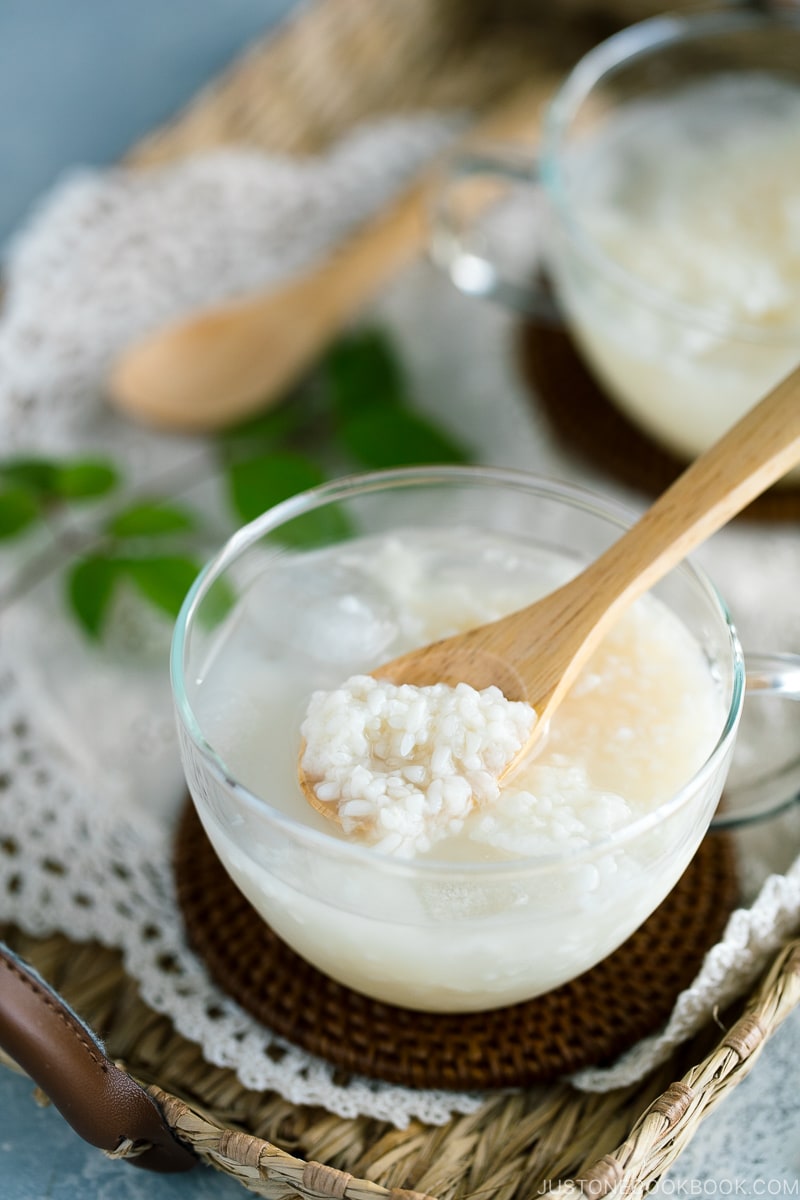
Drinking Amazake in Japan
If you have traveled to Japan before, you might have had a chance to try complimentary amazake at your ryokan, or even some souvenir shops. It is a popular drink served during New Year’s in Japan as well. Many temples and shrines provide it free of charge to worshippers on New Year’s Day and sell it for visitors to bring home.
Amazake is also served during Hina Matsuri (Doll Festival) held on March 3rd every year, as a non-alcoholic option to shirozake (白酒) – a sweet white sake with less alcohol, which is traditionally served on this day.
Amazake is the perfect winter drink. It’s healthy, comforting, sweet & creamy! Just what you need to keep warm and cozy until springtime.
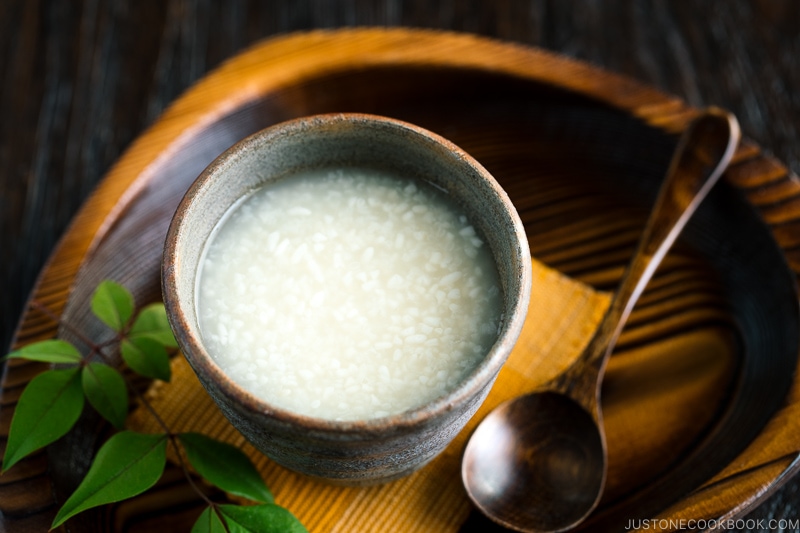
Wish to learn more about Japanese cooking? Sign up for our free newsletter to receive cooking tips & recipe updates! And stay in touch with me on Facebook, Pinterest, YouTube, and Instagram.
Amazake
Ingredients
For the Non-Alcohol Amazake with Rice Koji
- ¾ cup uncooked Japanese short-grain white rice (1 rice cooker cup, 180 ml)
- water (for cooking the rice porridge)
- 1 cup water (for cooling the porridge; you may need more or less)
- 1 cup rice koji
For the Low-Alcohol Amazake with Sake Lees
- 4 cups water
- ½ cup sake lees (sake kasu) (packed tightly)
- ¼ cup sugar (you can add more to taste)
- 1 pinch Diamond Crystal kosher salt (to taste)
Instructions
★ To Cook Amazake with Rice Koji
- Gather all the ingredients. Rinse and drain ¾ cup uncooked Japanese short-grain white rice and add to the inner pot of a rice cooker. Add water up to the 1 cup porridge water line. If there is no porridge water line, add water to the regular white rice 4 cup line. Select the Porridge menu on your rice cooker and press Start, or cook the porridge according to your rice cooker’s instructions.
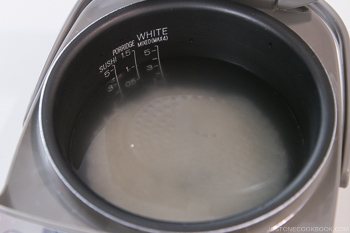
- Once the porridge is cooked, the temperature is around 175ºF (79ºC). Take out the inner pot with the porridge from the rice cooker.
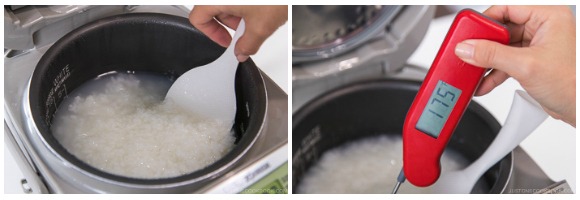
- Gradually add 1 cup water, ⅛ cup at a time, to the porridge, stirring thoroughly after each addition. Measure the temperature of the porridge with an instant-read thermometer. The temperature must cool down to 140ºF (60ºC) as koji mold cannot live above that temperature.
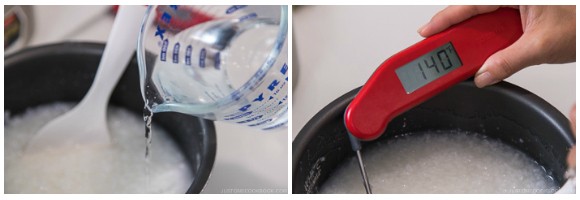
- Once the porridge reaches 140ºF (60ºC), crumble and add 1 cup rice koji. Stir thoroughly to incorporate. Make sure there is enough water to cover the porridge and rice koji so they are sufficiently soaked. If not, add warm water so it maintains 140ºF (60ºC).
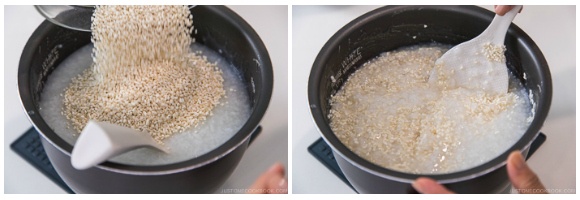
- Put the inner pot back into the rice cooker. Turn the rice cooker on to the Keep Warm (or Extended Keep Warm) setting and cover the opening with a cloth towel. Leave the rice cooker lid fully open so it does not get too hot. Allow the mixture to cook for 8–10 hours, stirring occasionally and checking the temperature every hour for the first 2–3 hours. Make sure it stays between 125ºF and 140ºF (50–60ºC) at ALL TIMES.
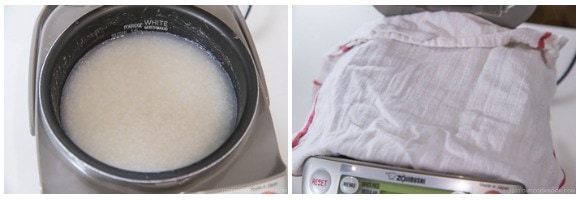
- Toward the end of 8 hours, the mixture will start to release a sweet fragrance. Once it’s done cooking, the mixture should smell sweet. Turn off the rice cooker and transfer the inner pot in a large bowl of ice water to let cool and stop the cooking. When cooled, transfer the Amazake to a large sterilized container.
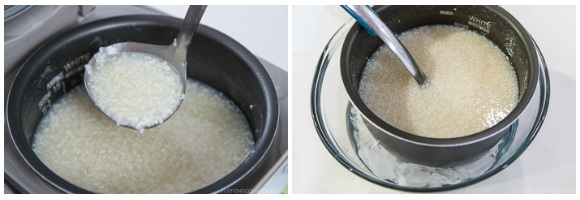
To Serve
- Take out the portion you need, dilute with either hot or iced water to your preferred consistency (I like mine thicker and undiluted), and serve chilled or warm (reheated). If you heat the Amazake above 140ºF (60ºC), the koji enzyme will die, so reheat it to lukewarm to retain the live enzyme. You can add grated ginger, if you‘d like. My kids love smoothies made with amazake, banana, and soymilk.
★ To Make Amazake with Sake Lees (Sake Kasu)
- Gather all the ingredients. Tear ½ cup sake lees (sake kasu) into small pieces.

- Bring 4 cups water to a boil in a large pot. Using a mesh sieve, dissolve the sake lees into the water. This step may take some time, but it‘s best to soften the lees first in the water so they will dissolve more easily. You don‘t want any chunks left in your amazake.
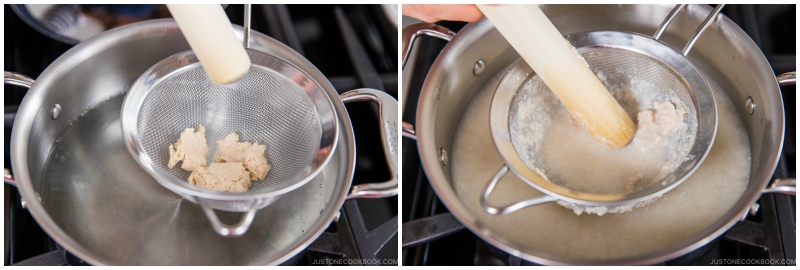
- Once dissolved, add ¼ cup sugar and 1 pinch Diamond Crystal kosher salt. Let it cook and reduce to your preferred consistency. I like a slightly thicker consistency, so I cook and reduce the amazake for 15 minutes or so. Serve hot/warm and enjoy!
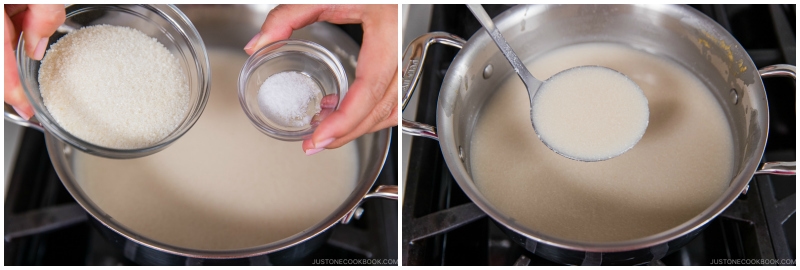
To Store
- You can keep in the refrigerator up to one week, or in the freezer for up to a month.
Nutrition
Did you make this recipe?
Tag @justonecookbook on Instagram so we can see your delicious creation!
Other Japanese Drinks You May Enjoy
- Plum Wine (Umeshu)
- Buckwheat Tea (Sobacha)
- Japanese Cream Soda
- How to Make Matcha (Japanese Green Tea)
- Japanese Iced Coffee
Editor’s Note: This post was originally published on January 8, 2018. The post has been edited in February 2020.


